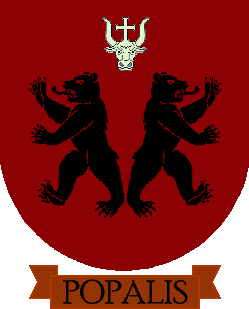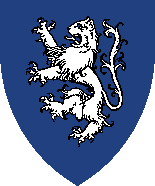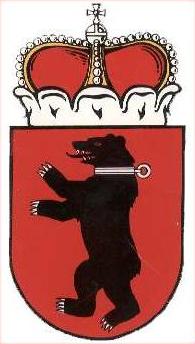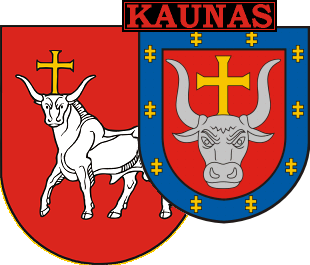
Home
Family
History
Coat of Arms
Military History
Lithuanian History
Shenandoah History
Image Galleries
Map Room
Scrapbook
Links
|
Popalis Family History

Coat of Arms
The Facts about a Coat of Arms
according to Fleur-de-lis
Fleur-de-lis, a company that produces coats and crests, states that coats of arms belong to individuals not surnames. "Coats of arms are not awarded to a family or a name, but to an individual. This is why there is often more than one coat of arms associated with a given surname. In England, a direct descent is required for any heir to have the legal right to bear his ancestor's coat of arms."
Fleur-de-lis also describes the probable results of any surname search. "You can try to narrow the search by geographic region of origin, but there may also be more than one coat of arms awarded to several people in ancient Germany. Further complicating the issue is that the authoritative source information for most coats of arms only lists a city and/or county or origin, and sometimes only a country. That is why, unless you can trace your family history to one individual, and unless the sources list that individual, then the best that you can hope for is to find a coat of arms that is the oldest for a given name from a given region or the one most frequently used. Coats of arms usually started out fairly simple in design, then subsequent generations added onto or made slight variations to the design to make it their own. Marriages often resulted in a combination of two different family lines' coats of arms."
Another search alternative is to try contacting the College of Arms for the country you believe your ancestor is from, for a fee they will search their records to see if a coat of arms was awarded to your ancestor.
It is important to keep in mind that the bearing of coats of arms is not regulated in most countries, including the United States. Because of this there has been a proliferation of "family name" companies offering histories and coats of arms for a given surname. "While there is no reason we cannot enjoy the decoration of a coat of arms associated with someone centuries ago who shared our surname, we should be aware that this is all that it is - a decoration."
"There is also no reason we cannot create a coat of arms and crest for ourselves, whether based on the coat of arms of an ancestor who shared our name (and may or may not be related to us), or designed from scratch to mean something special to our own lives and family."
The Popalis Coat of Arms

On the POPALIS coat of arms the two semi-rampant bears stand before a feild of red. The bear, in heraldic imagry, represents ferocity in the protection of kindred. The bear also holds special meaning for Lithuanian coats, more on that can be found below. The color red represents military fortitude and magnanimity. The bear facing right looks to the old country and the bear facing left looks to those in the new world. The wild ox (with a cross on his head) at the top comes directly from the coat of arms for the city of Kaunas and the Kaunas district. Joseph Popalis indicated his father, Andrew Popalis, identified this area as the Popalis home in Lithuania.
The Search
by Andrew Popalis
The search for family information, of any kind, will never really end. My search for family information began on the Internet, and when the results were less than satisfying, I tried a "family name" company. These companies can be found all over the Internet, they charge to research your family name and then try to sell you an array of personalized products. All family research companies use the same database of genealogical information, which goes back to about 1100. After placing my order and waiting an unusually long period of time, I tried to find out what was going on. I repeatedly sent e-mail, which only resulted in one generic response that did not address my question. I was disgusted but I knew that "Popelis" was not common and difficult to research. After an even longer period of time, a cardboard tube arrived in the mail. When I unrolled the scroll it described an ancestral tie to Bavaria.The name "Poppen" was associated with tribal conflicts during the Middle Ages. Name variations would
later include "Poppenberger", "Popenhagen" and "Poppelman". The scroll did not contain any link to any name residing in or immigrating to Lithuania. It did not include any name variation more closely resembling "Popelis". Without any record of a "Poppen" in Lithuania, I have to ask myself, "How do they know that 'Popelis' descended from 'Poppen'". The one bit of useful information that I had found on the Internet stated; "Popelis has German roots from the German names Poepel, Popel. Even though this surname comes from a German language root it has all of the basic elements of an original Lithuanian name. Popelis is a rare name in Lithuania - only five Popelis(es) live there." (Charles J. Zemaitis, Decatur, IL.)Then why did the earliest known record reveal "Poppen" and not something like "Poppel". These are two very different sounds. "Poppelman" is somewhat close, but why would a name based on 'Popel' not include an "l" sound until much later in history. Maybe "Poppen" and "Popelis" have a common ancestor who dates back further than records are able to trace. This much I do believe, there is not enough evidence to prove or disprove that "Poppen" is the ancestor of "Popelis".
 The "Poppen" coat of arms is a rampant lion with a blue background. Rampant lions were quite common on ancient Bavarian crests. This coat is no doubt a variation or portion of the crest of whichever nobelman or prince the Poppens declared allegiance to.
The "Poppen" coat of arms is a rampant lion with a blue background. Rampant lions were quite common on ancient Bavarian crests. This coat is no doubt a variation or portion of the crest of whichever nobelman or prince the Poppens declared allegiance to.
 It has been asserted that as early as the 14th century the seal of a bear on all fours was displayed on official documents of Grand Duke Vytautas. The Samogitian Cultural Association Editorial Board had a very detailed site which contained indepth information on the Samogitian region of Lithuania. The ancient seal of the Grand Duke has its origins in Samogitia. "The first record of the Samogitian bear among the official seals of the Grand Duchy dates to 1669." This was during the rule of Mykolas Kaributas Visnioveckis. The seal remained in use until the third partition of Poland-Lithuania in 1795. "The origin of the Samogitian coat of arms is possibly related to the legendary theory of the Roman origin of Lithuanians. According to this story one of the Roman tribes that settled in Lithuania was named Ursinai (lat. ursus = bear). If this is true, then it is not clear if the Roman origin of Lithuanians is supported by the Samogitian use of the bear or if the Samogitians cleverly used the bear to develop the legend."
It has been asserted that as early as the 14th century the seal of a bear on all fours was displayed on official documents of Grand Duke Vytautas. The Samogitian Cultural Association Editorial Board had a very detailed site which contained indepth information on the Samogitian region of Lithuania. The ancient seal of the Grand Duke has its origins in Samogitia. "The first record of the Samogitian bear among the official seals of the Grand Duchy dates to 1669." This was during the rule of Mykolas Kaributas Visnioveckis. The seal remained in use until the third partition of Poland-Lithuania in 1795. "The origin of the Samogitian coat of arms is possibly related to the legendary theory of the Roman origin of Lithuanians. According to this story one of the Roman tribes that settled in Lithuania was named Ursinai (lat. ursus = bear). If this is true, then it is not clear if the Roman origin of Lithuanians is supported by the Samogitian use of the bear or if the Samogitians cleverly used the bear to develop the legend."
 Displayed above are the Kaunas city and district Coat of Arms. The ox represents valour and generosity, the cross represents faith.
Displayed above are the Kaunas city and district Coat of Arms. The ox represents valour and generosity, the cross represents faith.
I have gathered these bits of information, found scattered here and there, and tried my best to make sense of them, all the time continually looking for new information that might lead me to my ancestors. Maybe someday I will be able to look back on this journey with a feeling of accomplishment. Until then I will keep searching.
Copyright © 2000 - 2014 by Andrew J. Popalis
All Rights Reserved
Privacy Policy
|